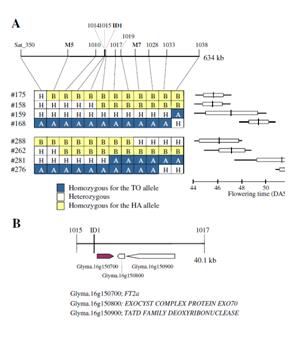plant biology:东北地理所揭示E9基因及其开花期调控机理

大豆光周期和成熟期的研究对于大豆适应不同纬度以及大豆产量的提高具有重要意义。虽然目前已经克隆的E1、E2、E3和E4基因的变异对大豆适应不同光周期环境起着关键性的作用,但是对开花期和成熟期自然变异的分子机理研究较少。利用早熟品种构建的杂交群体,中国科学院东北地理与农业生态研究所检测到两个控制开花期的主要位点:E1和E9。由于E1已经被克隆,因此该研究以E9为切入点,结合精细定位、测序和表达分析技术,明确E9基因就是FT2a基因。无论是何种光周期条件,e9的转录表达水平始终低于E9,从而延迟开花期。此外,测序结果表明,E9和e9的编码序列相同,但在启动子、非编码区以及内含子区域有一系列的单碱基置换、片段插入和片段缺失的变化。其中,e9在第一个内含子中含有一个Ty1/copia类似的反转录转座子SORE-1,高度甲基化的SORE-1虽然不会影响FT2a的RNA加工过程,但是SORE-1作为转录抑制因子,其插入会降低GmFT2a的表达水平。
综上,E9基因就是FT2a基因,e9因为插入了具有抑制活性的SORE1转录因子,从而降低了FT2a的转录水平,最终延迟大豆的开花期。e9的发现不仅能够延长早花品种的营养生长期,而且作为长童期性状的一个有效基因能够延长短日照条件下的开花期,从而为低纬度的育种提供理论依据。

该研究成果于1月19日在BMC plant biology(http://link.springer.com/article/10. 186/s12870-016-0704-9)杂志上在线发表,标题为A recessive allele for delayed flowering at the soybean maturity locus E9 is a leaky allele of FT2a, a FLOWERING LOCUS T ortholog,东北地理所大豆分子设计育种重点实验室研究员刘宝辉和孔凡江为论文责任作者
原文连接:
A recessive allele for delayed flowering at the soybean maturity locus E9 is a leaky allele of FT2a, a FLOWERING LOCUS Tortholog
原文摘要:
Understanding the molecular mechanisms of flowering and maturity is important for improving the adaptability and yield of seed crops in different environments. In soybean, a facultative short-day plant, genetic variation at four maturity genes, E1 to E4, plays an important role in adaptation to environments with different photoperiods. However, the molecular basis of natural variation in time to flowering and maturity is poorly understood. Using a cross between early-maturing soybean cultivars, we performed a genetic and molecular study of flowering genes. The progeny of this cross segregated for two maturity loci, E1 and E9. The latter locus was subjected to detailed molecular analysis to identify the responsible gene.
作者:刘宝辉,孔凡

